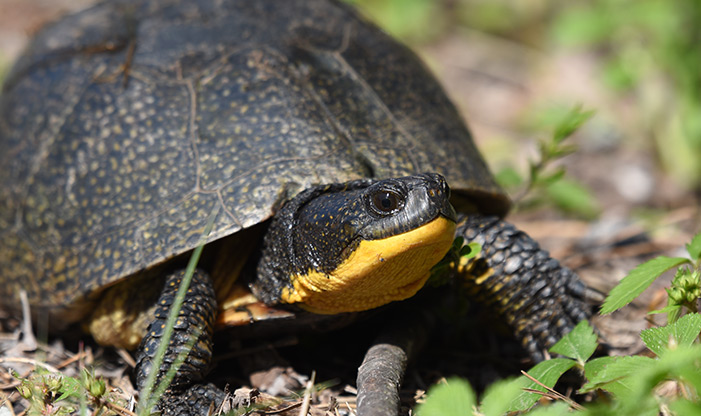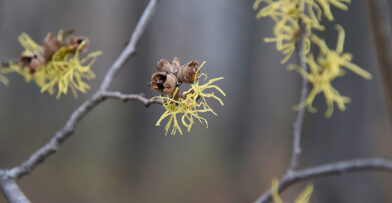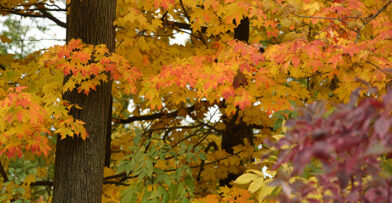It is nearly impossible for our eyes to grasp what takes place below the surface of a pond. Inside them, vital indicator species will swim, eat, procreate, and hunker down for winter. Some of these most fascinating creatures are reptiles and amphibians, and aside from turtles sunning on a log, we rarely notice them.
Turtles at Schlitz Audubon
The Center’s grounds are home to three species of turtles: painted turtles, known for their contrasting colors, snapping turtles, famous for their strong bite, and Blanding’s turtles, which are a Species of Special Concern in Wisconsin. Turtles are reptiles, called chelonians, and are easily identifiable by their protective shells. From an evolutionary standpoint, the leap that allowed reptiles to divorce themselves from living in the water is the amniotic egg. This is unlike the amphibians, which have a larvae stage, such as tadpoles. So for reptiles, the egg came first.
Reptiles and amphibians live in similar habitats, so it can be easy to overlook their differences. Reptiles have thicker skin than amphibians and are covered with scales instead of mucus glands. Reptile fertilization is also internal, differing from many amphibians (excepting our salamanders). Reptiles are relative exhibitionists, lying across any surface in the sunlight. By contrast, amphibians prefer areas that are cool, dark, and moist. One often has to overturn a few dozen logs to find a single salamander. Although it is exciting to uncover them, this practice is harmful to salamanders and their habitat.
The Wonderful World of Salamanders
At the Center, blue-spotted salamanders are the only confirmed salamander on the property. Mudpuppies were introduced to select ponds decades ago. Given that they are bottom pond dwellers, we cannot definitively say whether they exist on the property. But mudpuppies are known to reside in Lake Michigan.
Salamanders have a fascinating method of courtship, in which males create a spermatophore structure on the bottom of the pond. After a courtship dance, the female then locates the specific male’s spermatophore and fertilizes her eggs. Within days she will lay a golfball to baseball-sized egg mass of 30 – 250 eggs.
Fantastic Frogs
Frogs are also amphibians, and when we hear frogs and toads call in springtime, akin to birds, it is indeed the males attempting to woo females. If you see a smaller frog on the back of a larger frog, chances are you’re witnessing amplexus, which is frog courtship. Males possess special nuptial pads on their toes to grasp onto the female during amplexus. The smaller male clings the back of the female and fertilizes eggs as they are released from her body.
Frogs belong to the order Anurans, which translates to “without a tail,” in Greek. People often wonder how frogs differ from toads, but toads are actually a type of frog. Toads live farther away from water than other frogs, but still need to return to water to procreate. They have thicker skin than more water-oriented frogs. They also have smaller legs to hop shorter distances, unlike frogs with their longer leaping legs. Since toads aren’t as fast as other frogs, they need different methods to protect themselves. Parotid glands behind their eyes produce a poison that makes them taste nauseating to predators.
The name amphibian translates to “dual lives,” referencing their tadpole, or larval, stage of living in a pond, and then their adult stage in which they’re able to exist outside of water. But nearly all of them return to water to perpetuate their species.
Amphibians are Important Indicator Species
Amphibians provide an important link in the food chain. Some of our most dramatic predators that migrate through or exist at the Center, such as Green Herons, gray and red foxes, and raptors, rely upon frogs as a food source. For centuries, farmers have released toads in their agricultural fields because they eat bugs. Each time you open an unblemished ear of corn, remember to thank a toad.
Amphibians are vital indicator species and are often the first animals to inform us when something is amiss in the ecosystem. The permeability of their thin skin makes them susceptible to environmental changes. Their dual lifestyle can inform people about the overall quality of both wet and terrestrial environments. One could consider amphibians the proverbial canaries outside of the coalmine. So, the existence of frogs is an indication that we are being responsible caretakers of an ecosystem. Their absence is an indication that something has gone awry.
The Health of Amphibian Populations
Overall, amphibian species are in decline across the world for a variety of reasons. Habitat loss and pollution are two of the biggest problems. Gary Casper is a research scientist at the UW-Milwaukee field station in Saukville. He contributed research and writing to The Vanishing Present: Wisconsin’s Changing Lands, Waters, and Wildlife. According to Casper’s research, in Milwaukee County, 46% of the species of amphibians and reptiles native to the county have disappeared.
The people who manage nature centers and natural areas, however, are working together to bolster the populations of these vulnerable animals. Through Casper, Schlitz Audubon provided blue-spotted salamander eggs to Mequon Nature Preserve to reintroduce a population on their property. Later, Schlitz Audubon secured a wood frog egg mass from the Freiss Lake area to place in one of our ponds. We are pleased to report, that in spring 2017, for the first time in decades, we heard at least three male Wood Frogs calling to females.
As easy as it may be to disregard amphibians, these indicator species perform functions that far outweigh their diminutive stature. The habitats where many amphibians live – wetlands and ponds – provide vital ecosystem services such as water filtration and stormwater retention. They offer habitat for many other species as well. If amphibians are indicating their habitat is unhealthy, it is an indication that our living and working, and playing space is also unhealthy. So when the frogs stop calling, we should all be listening.


